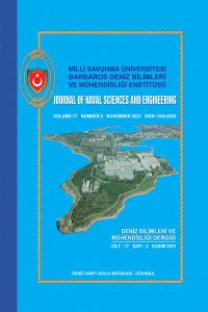SU ÜSTÜ GEMİDE DİZEL YAKITLI KATI OKSİTLİ YAKIT PİLİ SİSTEMİ TASARIMI VE ANALİZİ
Katı oksitli yakıt pili, Dizel yakıt, Su üstü gemi, Termodinamik analiz, Dizel elektrik jeneratör grubu
Design And Analysis Of Diesel Fueled Solid Oxide Fuel Cell System Onboard Surface Ship
-,
___
- Marte Reenaas, Solıde oxıde fuel cell combıned wıth gas turbıne versus dıesel engıne as auxılıary power producıng unıt onboard a passenger ferry, Norwegian university of science and technology, February 2005
- Endresen.Q.,Sorgard.E.,SundetJ. K., Dalsoren S.B.,Berglen T.F.,Gravir G. And Isaksen I.S.A., Environmental impact of international sea transportation, accepted by the Journal of Geophysical Research, 2003
- Fuel Cell Handbook (Seventh Edition), U.S. Department of Energy Office of Fosil Energy, National Energy Technology Laboratory, November 2004
- Osamu Yamamoto, Solid oxide fuel cells: fundamental aspects and prospects, Electrochimica Acta 45 (2000) 2423–2435
- Christoph Stiller, Design, Operation and Control Modeling of SOFC/GT Hybrid Systems, Doctoral Theses at NTNU, 2006:28
- S. Singhal, K. Kendall (Eds.), High Temperature Solide Oxide Fuel Cells: Fundamentals, Design and Applications, Elsevier, 2003.
- Inyong Kang, Joongmyeon Bae, Autothermal reforming study of diesel for fuel cell application, Journal of Power Sources 159 (2006) 1283–1290
- U.S. Department of Defense, 2006, MIL-DTL-16884L, Detail Specification Fuel Naval Distilate, 23 October 2006
- NATO Standardization Agreement (STANAG) Stanag No:1385 (Edition 3), Guide Specifications (Minimum Quality Standards) For Naval Distillate Fuels, 20 April 2006
- Steinfeld G, Sanderson R, Ghezel-Ayagh H, Abens S, Cervi MC. Distillate fuel processing for marine fuel cell applications. AICHE spring 2000 meeting, 5–9 March 2000, Atlanta, GA, USA.
- S. Katikaneni, C. Yuh, S. Abens, M. Farooque, 2002, The direct carbonate fuel cell technology: advances in multi-fuel processing and internal reforming, Catalysis Today 77, 99–106
- Amphlett, J. C., Mann, R. F., Peppley, B.A., Roberge, P.R., Rodrigues, A., Salvador, J. P. (1998). “Simulation of a 250 kW Diesel Fuel Processor/ PEM Fuel Cell System.” International Journal of Hydrogen Energy. 71. 179-184
- Çoban, M., TURHAN, Java 2 Programming Manual (In Turkish), ALFA Yayınevi, Ticarethane Sok no 41/1 34410 Cagaloglu, Istanbul, ISBN 975-316-631-1
- S.Ahmed, M.Krumpelt, Hydrogen from hydrocarbon fuels for fuel cells, International Journal of Hydrogen Energy 26 (2001) 291-301
- Sorell, G., Corrosion-and heat-resistant nickel alloys, Guidelines for selection and application, Nickel Development Institute Technical Series No:10086, 1998
- Sunden, Bengt, High Temperature Heat Exchangers (HTHE), Proceedings of Fifth International Conference, Science, Engineering and Technology, September, 2005
- International Maritime Organization, 1998, Annex VI of MARPOL 73/78 “Regulations for the Prevention of Air Pollution from Ships”, International Maritime Organization, London, UK
- Corbett,James J. and Farrell,Alex, Mitigating Air Pollution Impacts of Passenger Ferries, Transportation Research Part D 7 (2002) 197-211
- S. Krummricha, B. Tuinstra, G. Kraaij, J. Roes, H. Olgun, Diesel fuel processing for fuel cells—DESIRE, Journal of Power Sources 160 (2006) 500–504
- ISSN: 1304-2025
- Yayın Aralığı: 2
- Başlangıç: 2003
- Yayıncı: Milli Savunma Üniversitesi Deniz Harp Okulu Dekanlığı
Determining Optimum Energy Strategies for Turkey by MARKAL Model
Egemen SULUKAN, Mustafa SAĞLAM, Tanay Sıdkı UYAR, Melih KIRLIDOĞ
İŞLETMELERDE İŞGÖREN BULMA VE SEÇME AŞAMALARI
Efficiency Measures In The Health Services With Dea - An Overview
Banu Çalış KENGİL, Nilgün GÖKMEN, Hakan TOZAN
SU ÜSTÜ GEMİDE DİZEL YAKITLI KATI OKSİTLİ YAKIT PİLİ SİSTEMİ TASARIMI VE ANALİZİ
MTU 16V 4000 M90 MARKA/MODEL DİZEL MAKİNE EGZOZ SİSTEMİ TASARIMI
